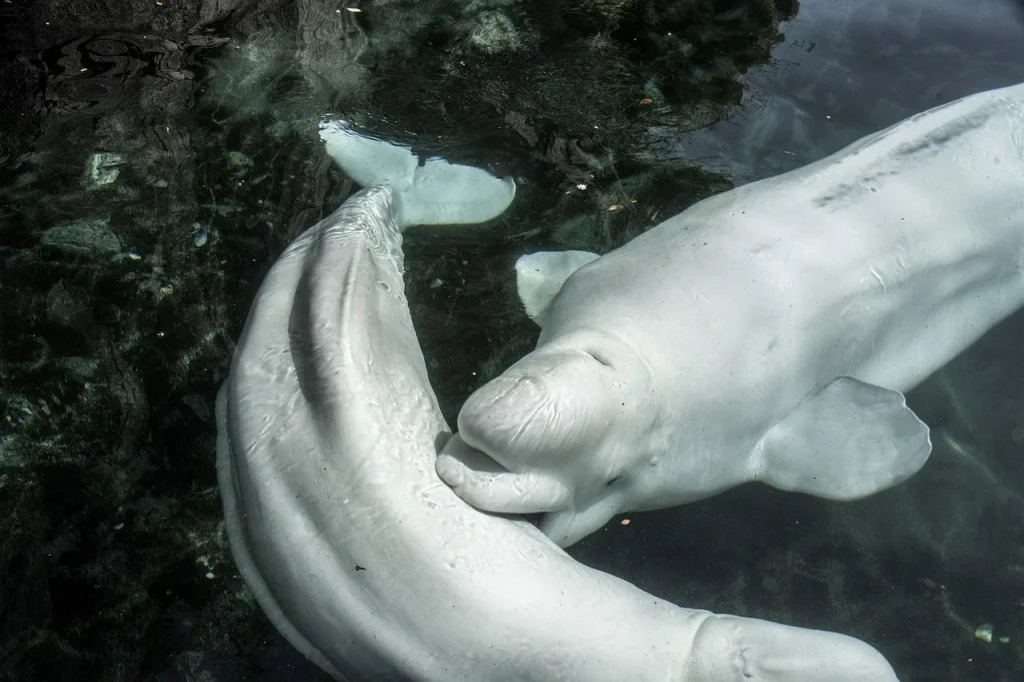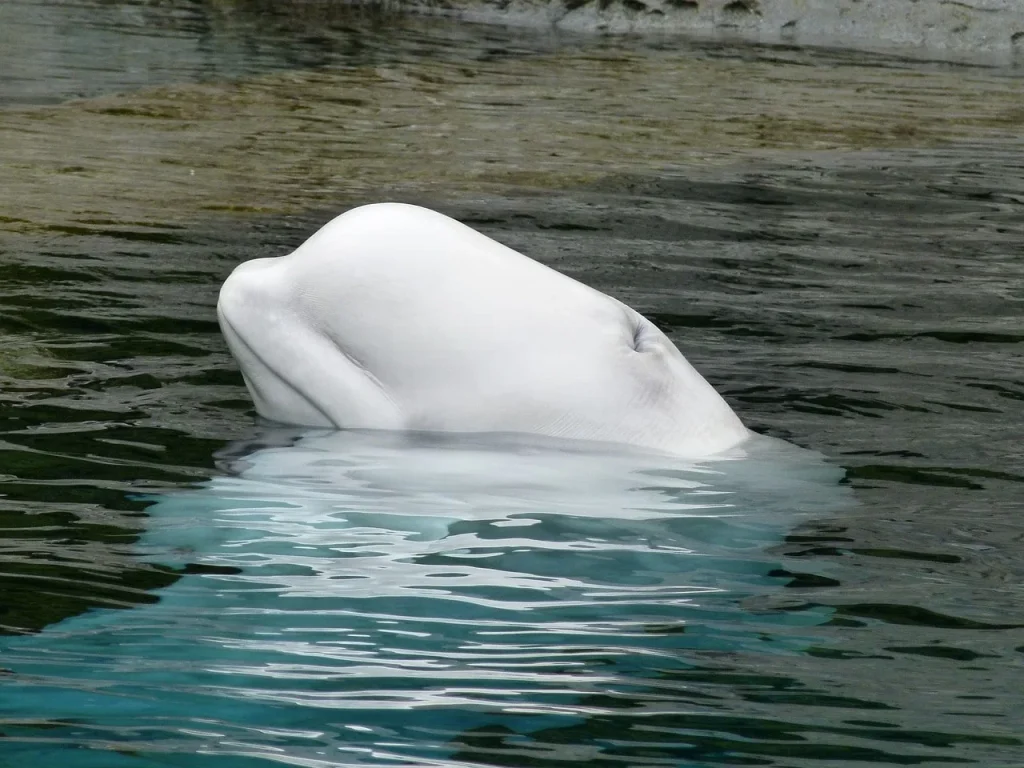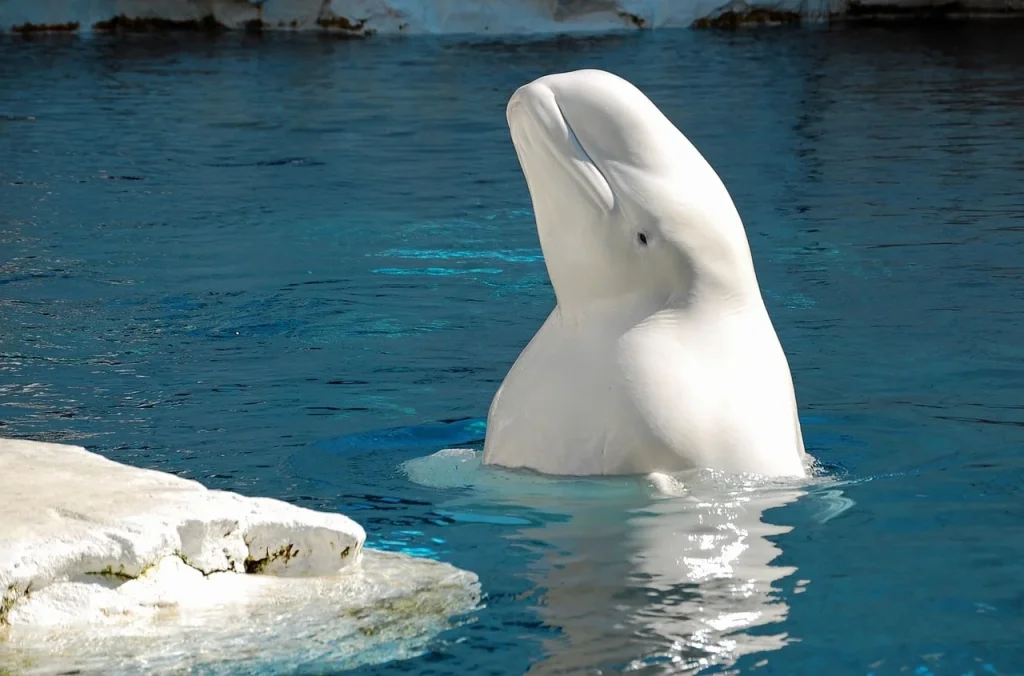Beluga whales are the ocean’s version of that one friend who’s always up for a laugh. With their expressive faces and playful behavior, they bring joy to the otherwise serene underwater world of the Arctic.
These whales are not just about fun and games; they play a crucial role in their ecosystem and have some pretty impressive skills, like being able to swim backwards. It’s not all smooth swimming, though; they also face challenges and have adapted in fascinating ways to thrive in their chilly home.
So, are you ready to dive into the intriguing world of beluga whales and learn why they’re the life of the Arctic party? Let’s go.
Beluga whales, those smiling sea canaries, serve as a barometer for the health of our oceans.
Sylvia Earle
Beluga Whale Facts
As you prepare to dive into the world of beluga whales, remember: every detail matters. A quiz at the end of this page will test your true understanding of these magnificent creatures.
- These creatures can change the shape of their bulbous forehead, known as a “melon”, to manipulate the sounds they produce.
- Despite being mammals, they spend their entire lives in icy Arctic waters, showcasing incredible adaptations to cold environments.
- Their skin sheds and regenerates during the summer in a process known as molting, a rare feature among marine mammals.
- They lack a dorsal fin, which is believed to be an adaptation to living in icy waters, preventing heat loss.
- Communication among these creatures involves a complex array of sounds, earning them the nickname “canaries of the sea”.
- Young calves are born gray and gradually turn white as they age, reaching full coloration by five to six years old.
- They possess a highly flexible neck due to the absence of fused cervical vertebrae, allowing them to nod and turn their heads in all directions.
- Social bonds are strong within pods, which can consist of up to several dozen individuals, including both family and non-family members.
- Belugas can dive to depths of over 700 meters (about 2,300 feet), though they typically stay within the first 20 meters of the water column.
- Their diet is varied, consisting of fish, crustaceans, and cephalopods, showcasing their adaptability as predators.
- They utilize echolocation to navigate and hunt in dark or murky waters, emitting sounds that bounce back from objects and prey.
- Inuit people have a deep cultural connection with these whales, respecting them as important components of their natural environment and survival.
- Migration patterns are influenced by sea ice coverage, with individuals traveling thousands of kilometers between summer and winter habitats.

- Their lifespan can extend up to 60 years, indicating a long maturation and reproductive period.
- Pollution and habitat degradation pose significant threats, highlighting the importance of conservation efforts.
- Some populations are resident year-round in certain areas, defying the common migration patterns observed in other marine species.
- Their ability to live under sea ice is exceptional, relying on polynyas (openings in the ice) and leads (cracks) to breathe.
- Underwater, they can swim backward, a rare capability among cetaceans that aids in navigating tight spaces and ice-laden waters.
- Research suggests they have distinct dialects, indicating a complexity in communication akin to that of human languages.
- Mother-calf bonds are exceptionally strong, with calves staying with their mothers for up to three years.
- They have very few natural predators, with only orcas and polar bears posing a significant threat.
- Their eyes are specially adapted to see both in and out of the water, providing them with exceptional vision in their aquatic environment.
- Climate change impacts their ice habitat, affecting migration, prey availability, and the overall health of their populations.
- Belugas can crossbreed with other whale species, though this is extremely rare in the wild.
- Their vascular system is highly adapted to manage the extreme pressure changes experienced during deep dives.
- Zoos and aquariums around the world have contributed to research on their physiology and behavior, yet this practice remains controversial.
- They are capable of rapid swimming, reaching speeds of up to 22 kilometers per hour (about 13.7 miles per hour).
- Belugas participate in altruistic behavior, such as aiding injured or stranded pod members.

- Their population status varies significantly by location, with some groups being threatened or endangered.
- Acoustic pollution from ships and industrial activity can interfere with their communication, navigation, and feeding behaviors.
- They have a remarkable ability to regulate their buoyancy, allowing them to hover motionless in the water.
- Legal protections have been established in many regions to mitigate threats from hunting and environmental degradation.
- Their teeth are not used for chewing; instead, prey is swallowed whole.
- Scientific studies utilize DNA analysis to understand the genetic diversity and health of populations across different regions.
- Traditional knowledge from indigenous communities has contributed significantly to understanding their migratory patterns and behavior.
- They use ice-breaking behavior to create breathing holes in thinner ice, demonstrating remarkable problem-solving abilities.
- Conservation efforts include satellite tagging to track migrations and study habitat use in the face of changing ice conditions.
- Their social structure is matrilineal, with females playing a central role in pod dynamics and leadership.

- Belugas can adapt their feeding strategies, including suction feeding and stirring up sediment, to catch prey.
- Their anatomical adaptations for sound production are among the most sophisticated in the animal kingdom.
- Observation in the wild is challenging due to their Arctic habitat, but advances in drone technology have improved research methods.
- Rescue and rehabilitation efforts for stranded individuals demonstrate the human capacity to positively impact their survival.
- Their brain-to-body ratio is one of the largest among marine mammals, suggesting a high degree of intelligence.
- Unique identifiers, such as scars and markings, are used by researchers to track individual whales over time.
- They have a strong curiosity towards humans and have been observed interacting with boats and divers.
- Their contribution to the marine ecosystem is critical, influencing prey populations and serving as indicators of ocean health.
- International cooperation is essential for their conservation, as their migratory routes cross multiple national boundaries.
- Research into their unique vocalizations continues to reveal new aspects of their communication and social structure.
- Despite their robust size, they are incredibly agile, able to navigate through ice with precision and grace.
- Their ability to imitate a variety of sounds, including human speech, has astounded researchers and laypeople alike.
Beluga Whale Myths

You’ve learned the facts about belugas, but what about the myths? Let’s continue our exploration by distinguishing fact from fiction. Prepare to be enlightened as we clear up some common misunderstandings.
- Belugas Can Live in Warm Waters
They are often thought to be adaptable to warm waters due to their friendly nature. However, they are strictly Arctic and sub-Arctic cetaceans. Warm water habitats are unsuitable for them because their thick blubber, evolved for cold environments, does not allow them to regulate their body temperature effectively in warm conditions. - Belugas are Mute
It is mistakenly believed that they are silent creatures. In reality, they are nicknamed “canaries of the sea” because of the wide range of sounds they produce. These sounds are used for communication and navigation through echolocation, demonstrating their highly social and acoustically active nature. - Belugas are White Throughout Their Lives
A common misconception is that belugas are born white and remain this color. In truth, they are born gray and undergo a gradual color change, reaching full whiteness at around five years of age. This transformation reflects their growth and maturity stages. - Belugas Have No Predators
The idea that belugas are free from predation risks is inaccurate. They are preyed upon by orcas (killer whales) and polar bears, particularly the young and weak individuals. Human activities also pose significant threats, including habitat destruction and pollution. - Belugas Can Easily Adapt to Captivity
Many believe that, due to their docile nature, belugas adapt well to captivity. However, captivity significantly impacts their physical and psychological health. The limited space and lack of social structures in captive environments are stark contrasts to their dynamic, wide-ranging life in the wild, leading to stress and behavioral issues.
No products found.
Beluga Whale FAQ

We are getting near the end of our journey. Read these FAQs carefully, as they are going to help you master the following trivia.
- Are beluga whales endangered?
They are currently listed as “near threatened” on the IUCN Red List. Their populations are at risk due to factors like habitat loss, pollution, and climate change. Efforts are ongoing to monitor and protect these creatures, but there’s a delicate balance to maintain to ensure their survival. - Why are beluga whale heads squishy?
The “squishy” part of their head is called the melon. This fascinating feature is a mass of fatty tissue that’s key to their echolocation abilities, allowing them to navigate and hunt in the murky waters of the Arctic. The melon’s fluid nature enables belugas to change their shape, helping to direct sound waves. - Are beluga whales dangerous?
They are not considered dangerous to humans. They are highly social creatures, known for their playful behavior and vocalizations. In captivity, they’ve been known to interact with humans in a gentle manner. However, like any wild animal, it’s essential to respect their space and environment. - How do beluga whales stay warm?
They have a thick layer of blubber that insulates their bodies against the frigid waters of their Arctic and sub-Arctic habitats. This blubber layer not only keeps them warm but also serves as an energy reserve during times when food might be scarce. - What do beluga whales eat?
They are opportunistic feeders, with diets that vary depending on their location and the season. They primarily eat fish, crustaceans, and cephalopods (like squid). Their prey selection often includes salmon, herring, shrimp, and other marine creatures found in cold water environments.
Beluga Whale Trivia

Welcome to the ultimate Beluga quiz! Get ready to dive deep into the world of these ghostly sea potatoes. Beware, though—score a zero and you might just wake up finding your bathtub occupied by a disgruntled beluga!
Conclusion
Reflecting on what we’ve learned about beluga whales, it’s clear that these creatures are more than just a pretty face. Their intelligence, social structures, and vocal abilities make them stand out in the animal kingdom.
They remind us of the ocean’s mysteries and the need to protect its inhabitants. Let’s keep spreading awareness and taking action for marine conservation. Till next time, stay curious and explore more. Cheers.


